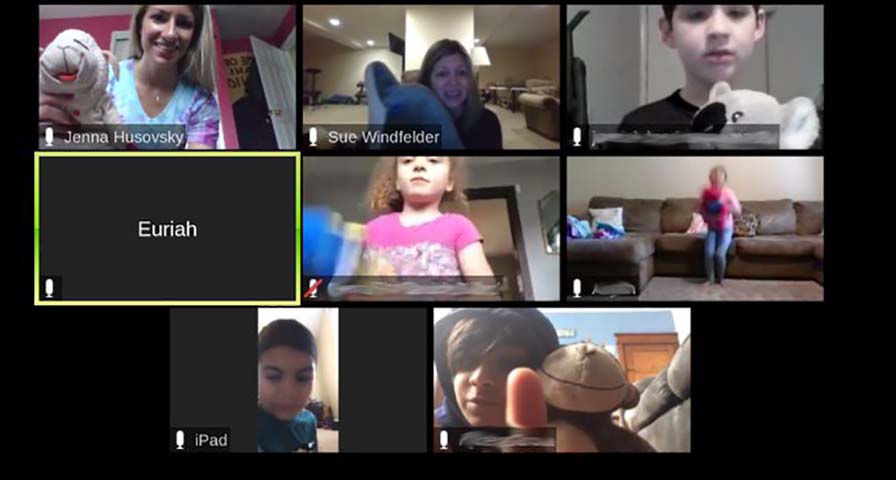Originally published May 3, 2020 in Lehigh Valley Live.
By Heather Mayer Irvine
When Gov. Tom Wolf closed Pennsylvania schools for two weeks on March 13, teachers and their students didn’t know it would be the last time they’d be together in the classroom. On April 9, he announced schools would be closed for the remainder of the school year as a result of the COVID-19 pandemic.
“All of this happened very abruptly,” says Courtney Weikert, a kindergarten teacher at Thomas Jefferson Elementary School in Bethlehem. “We didn’t get a chance to talk to (the kids) about it. They were nervous when they got home that night.”

PE teacher Jenna Husovsky leads a class that saw students and their stuffed animals perform exercises together. Photo from Husovsky’s Twitter feed.
To ease the nerves of her young students, Weikert recorded a video of her reading a story and pushed it out to her class’s social media channel. The response was so overwhelmingly positive that Weikert has recorded one story every day, including weekends, since the school closed nearly two months ago.
“I read to them because it’s something we did in the classroom, and it’s something they can count on every day,” she says.
These unprecedented times have forced teachers to think outside the classroom to engage, reassure and continue to educate their students.
Fun with Words
Christine Warfel, a second-grade teacher at Lehigh Elementary School in Lehigh Township, is using scavenger hunts as a way for her students to practice their spelling lists. Right now, they’re learning what’s called hunk-and-chunk words — a combination of certain letters that make a sound — and Warfel realized many of those words are common household items, like comb.
“To practice the list on our Google Meet, we’ll give the kids a clue and they have to find that item and bring it back,” she says.
For example, “what is something that you write with?” The hunk-and-chunk word is “write” because of the silent “w.” Warfel’s students brought back pens, markers and pencils.
Warfel has also used scavenger hunts to practice concepts, like cause-and-effect.
“I told the kids that we ate lunch and got messy, so what do we need?” she says.
They brought back napkins.
“The scavenger hunts are a good way for the kids to connect and see different parts of ourselves because they’re using things in their own homes. That’s not something we do in the classroom,” Warfel says. “And we’re tying in their phonics and spelling at the same time.”
Get Moving
With playgrounds closed and crummy weather, it’s been hard for kids to get outside to run around.
Jenna Husovsky, a physical education teacher at Calypso and Marvine elementary schools in Bethlehem, has been hosting weekly virtual lessons during lunch for her students in which they can practice their physical exercises (think: jumping jacks and butterfly stretches) or participate in an activity challenge.
But one class was having a particularly hard time without gym class, so their teacher asked if Husovsky could conduct a virtual session. She said yes.
During the class, one student needed a break from the exercises and came back to the screen holding his stuffed animal. That prompted the rest of the students, including their teacher, to bring their stuffed animals to the workout.
“It was not originally planned to be a class with stuffed animals,” Husovsky says.
But the animals joined in, including a body pillow-sized dolphin named Flip.
“Physical activity is hugely important, especially in a time like this,” Husovsky says. “It’s very easy for kids to be put in front of a screen especially because their workload is now in front of a screen.”
Husovsky has challenged her students to move with activities like fort-building, chalk-drawing and building a kite with items around the house.
“I keep it simple but also get them moving and into the fresh air,” she says. “It’s good for their mental health as well.”
Together, Apart
Denise McKeown, a first-grade teacher at Calypso Elementary School in Bethlehem, had plans to read “Flat Stanley,” a book about a boy traveling the world, to her students at the end of the school year. Disappointed she wasn’t going to be able to do that, she created and sent Flat Mrs. McKeown to her students.
McKeown created a cartoon version of herself and wrote her students a letter: “I know we can’t be together, so here is a flat version of Mrs. McKeown that you can take with you on your adventures while you’re at home.”
As soon as McKeown’s students received Flat Mrs. McKeown she started hearing about her paper version’s adventures, including bike rides, weightlifting, arts and crafts, and reading.
“My goal is just to let the kids know that I’m still here with them and even though I may not be physically with them, Flat Mrs. McKeown will help get them through the rest of the school year,” she says.
At Governor Wolf Elementary School in Bethlehem, some of the first-grade teachers have become pen pals with their students using traditional mail. Danette Walters read her students “The Letter” over video, in which Toad is sad because he never gets any mail. His friend Frog starts to send him letters, which inspired Walters’ students to do the same.
“I explained that I missed them and would wait on my porch, like Toad, for a letter from them,” she says.
Create Memories
Years from now, teachers want their students to remember not the fear and uncertainty surrounding the COVID-19 pandemic but the support and sense of community.
Lindsey Joseph, a third-grade teacher at William Penn Elementary School in Bethlehem, knew she would help her students create a memory book at the end of the year. That didn’t change when schools were closed, but she did have to get creative in how to execute the project.
Joseph put together a digital template for her students to fill out with things like their favorite memories of the year or how they would describe their teacher (“nise,” one student wrote). The goal, Joseph says, is to make sure her students know they’re in this together, even if physically apart.
“I wanted them to do something more creative and to have fun with it,” she says. “They miss school and each other.”
Another teacher at William Penn Elementary School has continued the tradition of a school-wide talent show through the school’s social media network. Eric Frank, a fourth-grade teacher, put out a call to the entire school to submit minute-long videos of their acts.
Frank has posted one video a day for nearly three weeks: dancers, a stand-up comic, a magician, musicians, a cyclist weaving through cones, a skateboarder (Frank, himself) and a dog performing tricks.
“The talent show is one of those events that gets the best participation,” he says. “The kids get really excited. It’s their time to shine. Right now, it reminds people that we can still have fun in tough times and it gives us a chance to not think about all the stress that’s there.”
In the end, these teachers want their students to remember the good that came from trying times. The kindergartners who started school for the first time in the fall may not have come back into the classroom for the remainder of the year, but their education and connection to each other never stopped.
“School was different but it didn’t stop,” Weikert says. “They weren’t ever really alone.”
Frank hopes the sense of community that his teachers, parents and students have built during a time of isolation continues when things start to return to normal.
“I want to look at this as one of the greatest victories of humanity,” he says. “We came together for a single purpose: to look out for each other.”
Seeking information about IHT’s Remote Learning program?




